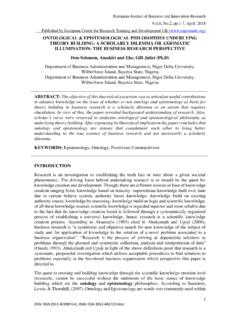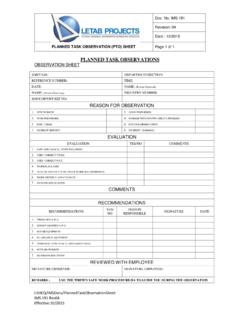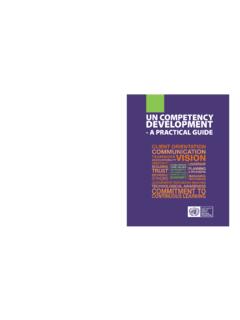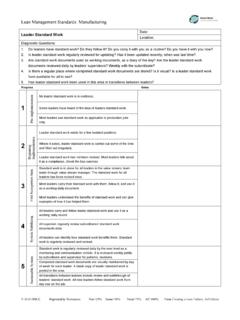Transcription of Data Collection Methods
1 2/1/2006 3:16 PM Page 97. 4. data Collection Methods . Q ualitative researchers typically rely on four Methods for gathering information: (a) participating in the setting, (b) observing directly, (c) interviewing in depth, and (d) analyzing documents and material cul- ture. These form the core of their inquiry the staples of the diet. Several secondary and specialized Methods of data Collection supplement them. This chapter provides a brief discussion of the primary and the secondary Methods to be considered in designing a qualitative study. This discussion does not replace the many excellent, detailed references on data Collection (we refer to several at the end of this chapter). Its pur- pose is to guide the proposal writer in stipulating the Methods of choice for his study and in describing for the reader how the data will inform his research questions.
2 How the researcher plans to use these Methods , however, depends on several considerations. Chapter 1 presents an introductory discussion of qualitative method- ological assumptions. As the grounding for a selection of Methods , we extend that discussion here, using Brantlinger's (1997) useful summary of seven categories of crucial assumptions for qualitative inquiry. The first concerns the researcher's views of the nature of the research: Is the inquiry technical and neutral, intending to conform to traditional research within her discipline, or is it controversial and critical, with an 97. 2/1/2006 3:16 PM Page 98. 98 DESIGNING QUALITATIVE RESEARCH. explicit political agenda? Second, How does she construe her location, her positioning relative to the participants: Does she view herself as dis- tant and objective or intimately involved in their lives?
3 Third, what is the direction of her gaze' : Is it outward, toward others externalizing the research problem or does it include explicit inner contemplation? Fourth, what is the purpose of the research: Does she assume that the pri- mary purpose of the study is professional and essentially private ( , promoting her career), or is it intended to be useful and informative to the participants or the site? Related to the fourth category is the fifth: Who is the intended audience of the study the scholarly community or the participants themselves? Sixth, what is the researcher's political positioning: Does she view the research as neutral or does she claim a politically explicit agenda? Finally, the seventh assumption has to do with how she views the exercise of agency: Does she see herself and the participants as essentially passive or as engaged in local praxis ?
4 (Brantlinger, p. 4). Assumptions made in these seven categories shape how the specific research Methods are conceived and implemented throughout a study. Explicit discussion of assumptions strengthens the overall logic and integrity of the proposal. PRIMARY Methods . observation observation entails the systematic noting and recording of events, behaviors, and artifacts (objects) in the social setting chosen for study. The observational record is frequently referred to as field notes detailed, nonjudgmental, concrete descriptions of what has been observed. For studies relying exclusively on observation , the researcher makes no spe- cial effort to have a particular role in the setting; to be tolerated as an unobtrusive observer is enough. Classroom studies are one example of observation , often found in education, in which the researcher docu- ments and describes actions and interactions that are complex: what they mean can only be inferred without other sources of information.
5 This method assumes that behavior is purposeful and expressive of deeper values and beliefs. observation can range from a highly struc- tured, detailed notation of behavior structured by checklists to a more holistic description of events and behavior. In the early stages of qualitative inquiry, the researcher typically enters the setting with broad areas of interest but without predetermined 2/1/2006 3:16 PM Page 99. data Collection Methods 99. categories or strict observational checklists. In this way, the researcher is able to discover the recurring patterns of behavior and relationships. After these patterns are identified and described through early analysis of field notes, checklists become more appro- priate and context-sensitive. Focused observation then is used at later stages of the study, usually to see, for example, if analytic themes explain behavior and relationships over a long time or in a variety of settings.
6 observation is a fundamental and highly important method in all quali- tative inquiry. It is used to discover complex interactions in natural social settings. Even in studies using in-depth interviews, observation plays an important role as the researcher notes the interviewee's body language and affect in addition to her words. It is, however, a method that requires a great deal of the researcher. Discomfort, uncomfortable ethical dilemmas and even danger, the difficulty of managing a rela- tively unobtrusive role, and the challenge of identifying the big picture while finely observing huge amounts of fast-moving and complex behavior are just a few of the challenges. Whether a researcher is simply observing from afar or finding a participant-observer role in the setting, some contexts may present dan- gers. Street ethnography is a term that describes research settings which can be dangerous, either physically or emotionally, such as working with the police (as Manning did, described in Chapter 3), drug users, cults, and situations in which political or social tensions may erupt into violence (Weppner, 1977).
7 Observations involve more than just hanging out. Planful and self-aware observers use observation systematically ( DeWalt & DeWalt, 2001). At the proposal stage, the researcher should describe the purpose of the observing, the phase of the study in which it is likely to be most fruitful, and the use of field notes to respond to the research questions. Field notes are not scribbles. The proposal writer should have explicit note-organizing and note-management strategies. Figure provides an example of edited and cleaned-up field notes for a study of kindergarten teachers. O'Hearn-Curran (1997) has formatted descrip- tive notes in a column on the left while reserving a second column on the right for her comments. These include her emerging analytic insights about the behavior. Observers' comments are often a quite fruitful source of analytic insights and clues that focus data Collection more tightly (more on this in Chapter 5).
8 They may also provide impor- tant questions for subsequent interviews. 2/1/2006 3:16 PM Page 100. 100 DESIGNING QUALITATIVE RESEARCH. Figure Sample Field Notes Tuesday, November 13, 1997 12:40 observation Observer's comments There are 17 children in the room. There are 3 adults: 1 teacher, 1 classroom assistant, and 1 student teacher (the student teacher is an older woman). The room is in the basement of the school. The school is a brick building approximately 90 to 100 years old. The room is about 40 feet by 30 feet. The room is carpeted and is sectioned off by furniture. There is an area with big books and a chart in the left-hand back corner of the room. Next to that is a shelf with a mixture of small books, tapes, and big books in The teacher seems to baskets. Next to that is a small area with toy kitchen have done a great job furniture and dolls.
9 There is an area with several of making the room tables in front of the kitchen area. There are many seem very inviting. The small chairs pulled up to the table. In the front of the space itself is not room is an area with a sand table. There is a optimal semicircle table in the left-hand front corner of the room. The walls are colorful with papers that have been made by the children. One wall has papers with apples on them. Another wall has pictures of children with their names on the front of the papers. There are several small windows in the room and the florescent lighting seems to be the major source of light. The children have just come into the room. They have Most of the children put their coats and backpacks onto their hooks in the appear to know the hall outside. routine Participant observation Developed primarily from cultural anthropology and qualitative soci- ology, participant observation (as this method is typically called) is both an overall approach to inquiry and a data -gathering method.
10 To some degree, it is an essential element of all qualitative studies. As its name suggests, participant observation demands firsthand involvement in the social world chosen for study. Immersion in the setting permits the researcher to hear, to see, and to begin to experience reality as the participants do. Ideally, the researcher spends a considerable amount of time in the setting, learning about daily life there. This immersion offers the researcher the opportunity to learn directly from his own experience. Personal reflections are integral to the emerging analysis of a cultural group, because they pro- vide the researcher with new vantage points and with opportunities to make the strange familiar and the familiar strange (Glesne, 1999). 2/1/2006 3:16 PM Page 101. data Collection Methods 101. This method for gathering data is basic to all qualitative studies and forces a consideration of the role or stance of the researcher as a participant observer her positionality.

















